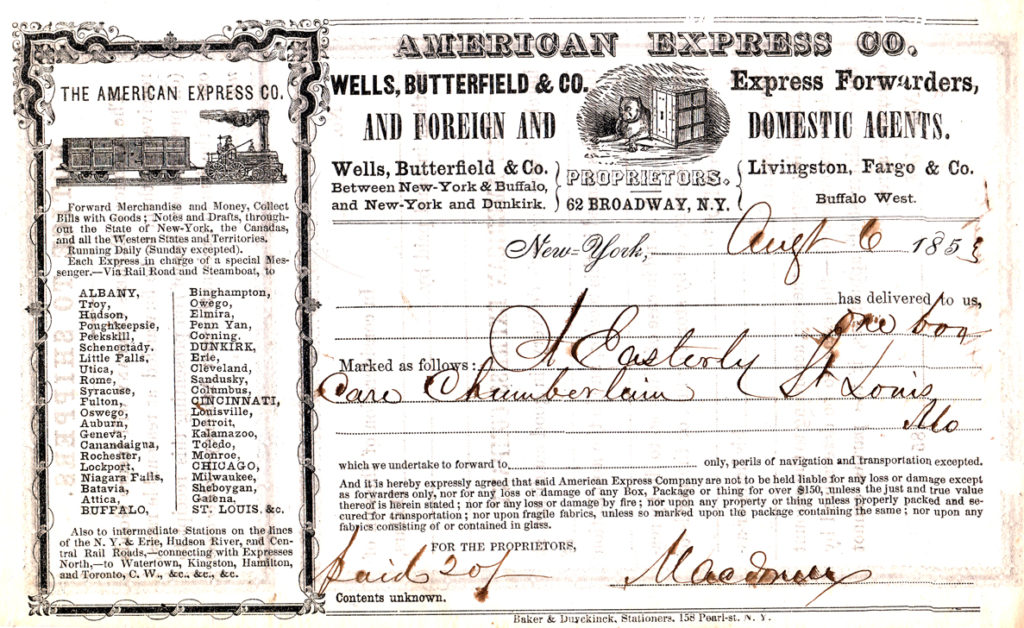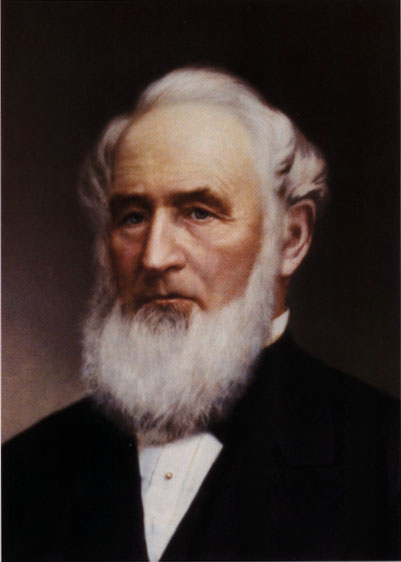
Did you ever get hit with something you feel like you really should have known, something that should just be common knowledge, and yet you had no idea? So here’s one of those things: American Express was started in Albany. And, there was a Wells Fargo connection as well. (Have to give thanks to a Facebook post by local newscaster Phil Bayly for the American Express information.) But maybe more importantly, Albany was the home of the very first package express delivery service.
It turns out the earliest express companies, which arranged for the movement of freight by canal and rail, were complicated and more than a little incestuous. They went in and out of business in very short periods of time, with this agent or that principal jumping ship to another company with alarming regularity. So actually tracking the genesis of what became the American Express Company is a bit complicated. Howell, in his otherwise invaluable “Bi-Centennial History of the County of Albany,” makes a bit of a mash of it, providing a wildly confusing series of names and relationships in the express business in Albany. But he is clear on one point:
“To William F. Harnden belongs the credit of recognizing a public want before the public had any definite idea of what that want was; and not merely recognizing it, but going practically to work with energy to supply it. He was the beginner and earliest practical worker of an institution which, for rapid growth and business importance, is without a parallel,” Howell wrote in 1886.
“The package express of modern times was unknown until Harnden started it in 1839 . . . The origin of the express, as an institution, was brought about by the introduction of the railway, which made a revolution in former methods. Business men began to require a more rapid and safe delivery of valuable packages and sundry parcels. The old way demanded large confidence, and sometimes became a burden and an inconvenience to friends and acquaintances. There are now living those who well remember how anxious men were to send by some friend going to New York or Boston, parcels of bank notes, drafts, bills collectable, or other valuables; and it was expected to be cheerfully performed as a favor.”
According to Howell, William F. Harnden was a conductor on the first train of the Boston and Worcester Railroad in 1834. He found the confinement injurious to his health (don’t imagine that the inside of an early rail car was a clean and healthy place to be), and told his friend James W. Hale he sought some more active business. Hale was somewhat of a pioneer in express himself: he carried letters at a reduced rate at a time when U.S. postage was actually fairly high. (Hale claimed to have been arrested for this act 450 times.) Hale suggested that Harnden run a parcel express between New York and Boston, which he did beginning in 1839.

Enter Henry G. Wells, a Vermonter who was a freight agent on the Erie Canal, who encouraged Harnden to extend his growing service to Albany and Buffalo and beyond. Harnden did start an Albany service in 1841, hiring Henry Wells as his agent, but he didn’t carry it further west. Wells, who had grown up near Seneca Falls and apprenticed at Palmyra, still thought the service should extend westward and suggested to a George Pomeroy that it would pay to start an express from Albany to Buffalo. This seems to have had a short run, then lay fallow, then a coal merchant named Crawford Livingston suggested it start up again, so Wells joined Pomeroy & Co.’s Albany and Buffalo Express, which shipped packages west once a week and could reach Buffalo in four nights and three days. Livingston, Wells and Pomeroy also began the Hudson River Express in 1842. “Pomeroy and Wells . . . served as the two messengers of the concern, having a desk in the Exchange Building, where the first express business was transacted in this city [Albany],” Howell wrote.
Meantime, Harnden sold the Boston to Albany route to James M. Thompson, who had an agent named Robert L. Johnson, in 1844. He also sold his Philadelphia route, which ended up in the hands of William A. Livingston, who sold out of the business there and moved to Albany to join brother Crawford’s business. They connected with the Fargo brothers, Williams, James and Charles, in Buffalo, running the Western Express Forwarders under the name of Livingston, Wells & Co., and, after Crawford’s death in 1847, Wells & Co.
There was a rival company started by James D. Wasson, an Albany postmaster, and John Warren Butterfield, a Berne native who started as a stage coach driver and established stage routes throughout the state, steamboats on Lake Ontario, a street railroad in Utica, and local plank-roads. And telegraphs. And banks. To say that Butterfield might have been the biggest tycoon ever to come out of Berne would likely go unchallenged. They formed Butterfield, Wasson & Co. in 1849.
So there were at least three rival express services, some of which had been in partnership with each other, operating from or through Albany. In 1850, those three companies – Wells & Co., Livingston & Fargo, and Butterfield, Wasson & Co. – came together as a stock company and formed The American Express Company. Henry Wells was President (until 1868), John Butterfield, Vice President; William C. Fargo, Secretary; Alexander Holland, Treasurer. Of course, the company saw phenomenal growth, and very quickly established its headquarters in New York City. Over the years, it absorbed a number of rival companies, such as the United States Express Company and Pomeroy’s Merchants Union Express Company. Many of these had their offices in the Exchange Building, at the northeast corner of State and Broadway now occupied by the former federal government building.
Howell wrote in 1886:
“The American Express Company doing business in Albany County is largely the growth from seed sown by such men as Henry Wells, Crawford Livingston, William A. Livingston, R.L. Johnson and George Pomeroy. More than two-score years ago, in 1841, when Harnden induced Henry Wells to serve him as agent, Wells, then young, sanguine, full of energy and willing to work, fixed his headquarters in Albany.”
Very shortly after its creation, there was an internal division; Wells wanted to extend the express operations westward to California; Butterfield and the other directors objected. Apparently, there weren’t non-compete clauses back then, because Wells enlisted Fargo in creating a western express company that you may have heard of.
Wells himself doesn’t appear to have spent much time in Albany; his first wife Sarah Daggett was from Schuylerville, but they lived in New York City (way out in Jamaica), in 1850, and shortly after the creation of American Express they moved to Aurora. Shortly after retiring from Wells Fargo and American Express, he founded Wells College on the grounds of his estate, one of the earliest women’s colleges in the country.
Butterfield created the Butterfield Overland Mail route, carrying U.S. mail and passengers between St. Louis and San Francisco. Debt forced him to sell out to Wells Fargo and he returned to his adopted city of Utica, where he served as mayor. Butterfield’s son Daniel is often credited with composing “Taps.”
The Fargo brothers, originally from Onondaga County and then Buffalo, bounced around Detroit, Chicago and New York City, but mostly stayed an express train away from Albany.
Additional details from The Express Gazette, Vols. 46-47; American Biography: A New Cyclopedia, Volume 2.

Leave a Reply